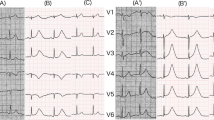Abstract
Among childhood psychiatric disorders, attention deficit hyperactivity disorder (ADHD) is of greatest interest to practitioners. Methylphenidate (MPH) is a drug that is widely used in the treatment of children in whom ADHD has been diagnosed. Although this treatment has been used for years, its effects on the heart remain the subject of debate. The QT interval comprises the ventricular activation and recovery periods as seen on electrocardiogram (ECG). The acute effect of MPH on QT interval dispersion is unknown. Researchers in the present study sought to investigate the acute effects of MPH on QT interval as seen on ECG. A total of 25 patients with ADHD (mean age, 9.4±2.1 y) who were treated with MPH were enrolled in the study. Twelve-lead derivation ECGs were taken before and 2 h after administration of 10 mg of MPH. Maximum QT interval, minimum QT interval, and interval durations were measured, and QT dispersion was calculated, for each ECG. QT dispersion measured after medication administration decreased significantly from 59.6±16.3 ms to 50.8±10.9 ms (P=.016); corrected QT dispersion decreased significantly from 70.9±17.6 ms to 61.3±13.3 ms (P=.011). Maximum QT interval duration decreased from 373.7±21.8 ms to 361.8±29.0 ms (P=.006); minimum QT interval duration rose from 317.0±23.3 ms to 322.3±21.6 ms (P=.312). In conclusion, the findings of this study show that MPH reduces QT dispersion during the acute period shortly after its administration.
Similar content being viewed by others
References
Safer DJ, Zito, JM, Fine EM. Increased methylphenidate usage for attention deficit disorder in the 1990s.Pediatrics. 1996;98:1084–1088.
Solanto MV. Neuropsychopharmacological mechanisms of stimulant drug action in attention deficit hyperactivity disorder: a review and integration.Behav Brain Res. 1998;94:127–152.
Hinshaw S, Heller T, McHale JP. Covert antisocial behavior in boys with attention-deficit/ hyperactivity disorder: external validation and effects of methylphenidate.J Consult Clin Psychol. 1992;60:274–281.
Rapoport JL, Inoff-Germain G. Responses to methylphenidate in attention-deficit/hyperactivity disorder and normal children: update 2002.J Attention Disord. 2002;1:57–60.
Nissen SE. ADHD drugs and cardiovascular risk.N Engl J Med. 2006;354:1445–1448.
Turkmen M, Barutcu I, Esen AM, et al. Assessment of QT interval duration and dispersion in athlete’s heart.J Intern Med Res. 2004;32:626–632.
Mirvis DM, Goldberger AL. Electrocardiography. In: Braunwald E, Zipes DP, Libby P, eds.Heart Disease, 6th ed. Philadelphia, Pa: WB Saunders; 2001:82–128.
Alpaslan M, Onrat E, Yilmazer M, Fenkci V. QT dispersion in patients with polycystic ovary syndrome.Jpn Heart J. 2002;43:487–493.
Gracious BL. Atrioventricular nodal re-entrant tachycardia associated with stimulant treatment.J Child Adolesc Psychopharmacol. 1999;9:125–128.
Lucas PB, Gardner DL, Wolkowitz OM, Tucker EE, Cowdry RW. Methylphenidate-induced cardiac arrhythmias.N Engl J Med. 1986;315:1485.
Langlois Y. Ventricular tachycardia associated with methylphenidate.Can Med Assoc J. 1968; 98:698.
Turgay A. DSM-IV-Based Child and Adolescent Behavior Disorders Screening and Rating Scale (unpublished). Toronto, Ontario, Canada: Integrative Therapy Institute; 1995.
Ahnve S. Correction of QT interval for heart rate: review of different formulas and the use of Bazett’s formula in myocardial infarction.Am Heart J. 1985;109:568–574.
Lazar J, Manzella S, Moonjelly J, Wirkowski E, Cohen TJ. The prognostic value of QT dispersion in patients presenting with acute neurological events.J Invasive Cardiol. 2003;15:31–35.
Kuo CS, Redy CP, Munakata K, Surawicz B. Mechanism of ventricular arrhythmia caused by increased dispersion of repolarization.Eur Heart J. 1985;6:63–71.
Paventi S, Bevilacqua U, Parafati MA, Di Luzio E, Rossi F, Pelliccioni PR. QT dispersion and early arrhythmic risk during acute myocardial infarction.Angiology. 1999;50:209–215.
Algra A, Tijssen JG, Roelandt JR, Pool J, Lubsen J. QTc prolongation measured by standard 12-lead electrocardiography is an independent risk for sudden cardiac death due to cardiac arrest.Circulation. 1991;83:1888–1894.
Macfarlane PW, McLaughlin SC, Rodger JC. Influence of lead selection and population on automated measurement of QT dispersion.Circulation. 1998;98:2160–2167.
Ileri M, Yetkin E, Tandogan I, et al. Effect of habitual smoking on QT interval duration and dispersion.Am J Cardiol. 2001;88:322–325.
Murray A, McLaughlin NB, Campbell RW. Measuring QT dispersion: man versus machine.Heart. 1997;77:539–542.
Patrick KS, Caldwell RW, Ferris RM, Breese GR. Pharmacology of the enantiomers of threo-methylphenidate.J Pharmacol Exp Ther. 1987;241:152–158.
Aoyama T, Kotaki H, Honda Y, Nakagawa F. Kinetic analysis of enantiomers of threo-methylphenidate and its metabolite in two healthy subjects after oral administration as determined by a gas chromatographic-mass spectrometric method.J Pharm Sci. 1990;79:465–459.
Faraj BA, Israili ZH, Perel JM, et al. Metabolism and disposition of methylphenidate-C14: studies in man and animals.J Pharmacol Exp Ther. 1974;191:535–547.
Ballard JE, Boileau RA, Sleator EK, Massey BH, Sprague RL. Cardiovascular responses of hyperactive children to methylphenidate.JAMA. 1976;236:2870–2874.
Lee S, Harris ND, Robinson RT, Yeoh L, Macdonald IA, Heller SR. Effects of adrenaline and potassium on QTc interval and QT dispersion in man.Eur J Clin Invest. 2003;33:93–98.
Author information
Authors and Affiliations
Corresponding author
Rights and permissions
About this article
Cite this article
Ilgenli, T.F., Congologlu, A., Ozturk, C. et al. Acute effect of methylphenidate on QT interval duration and dispersion in children with attention deficit hyperactivity disorder. Adv Therapy 24, 182–188 (2007). https://doi.org/10.1007/BF02850007
Issue Date:
DOI: https://doi.org/10.1007/BF02850007




